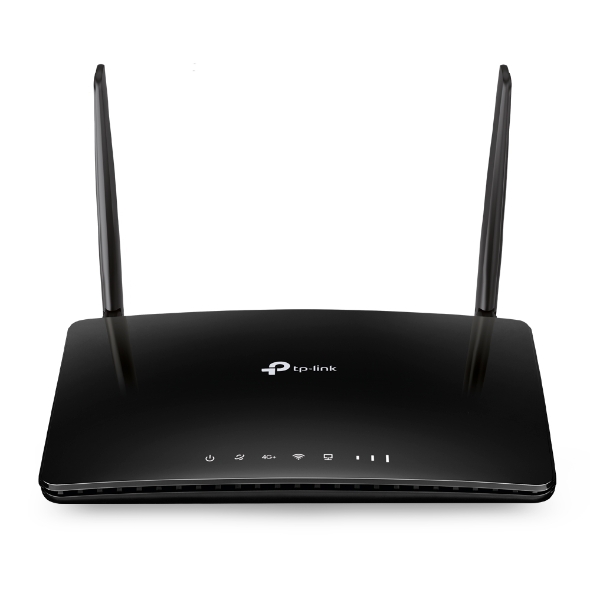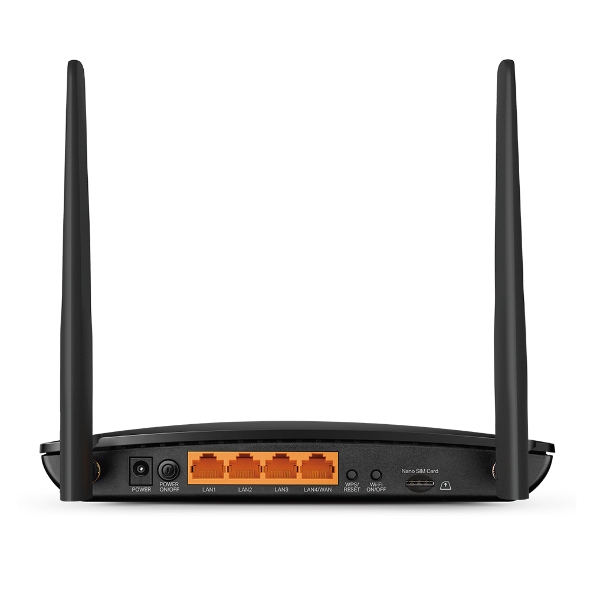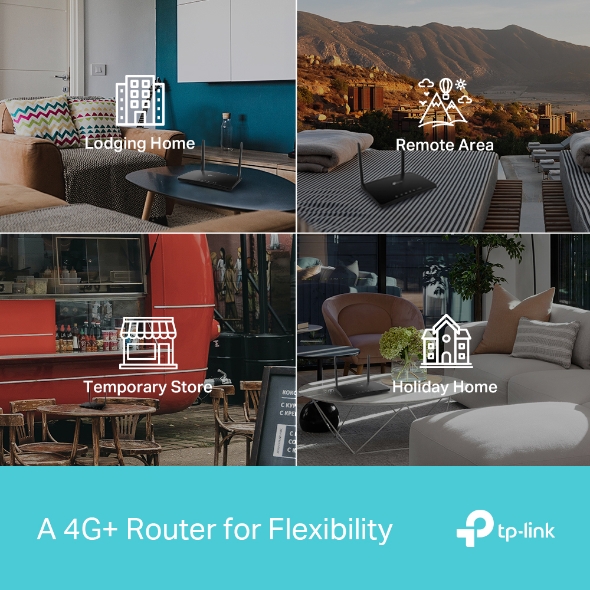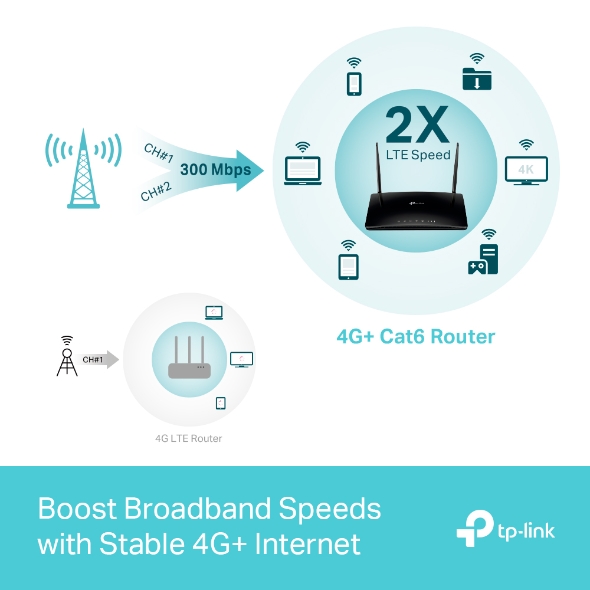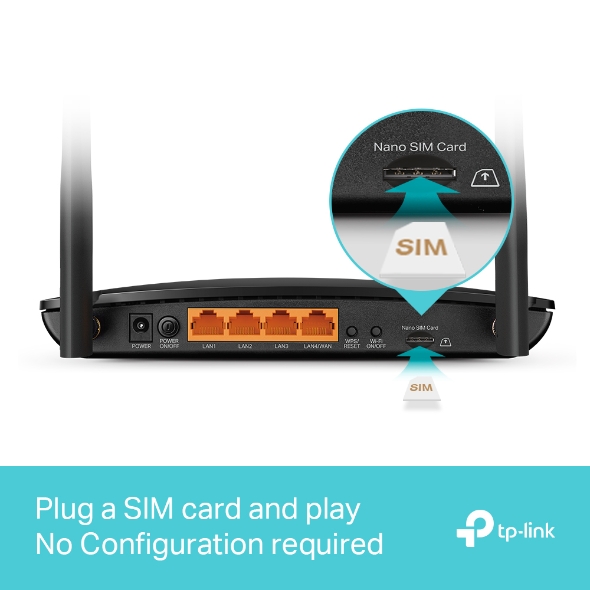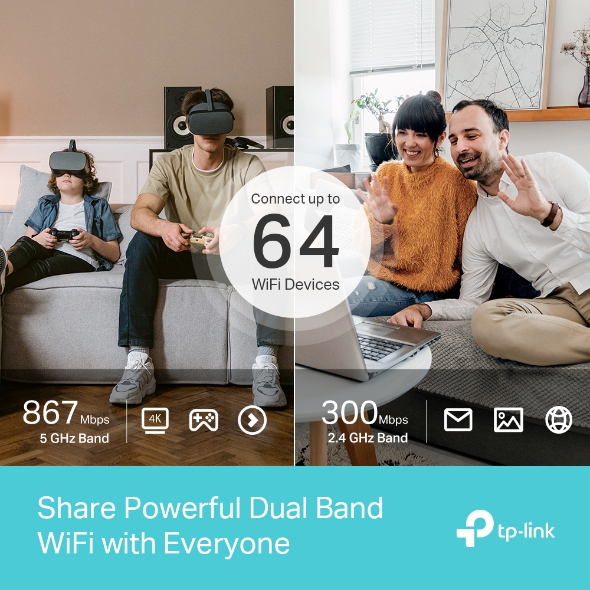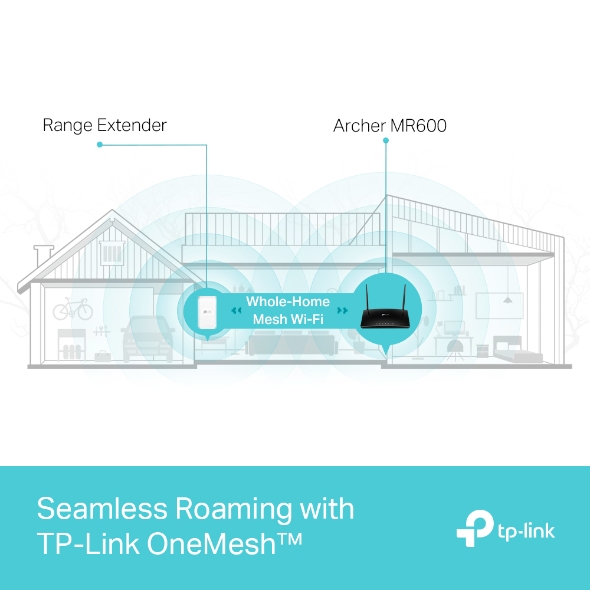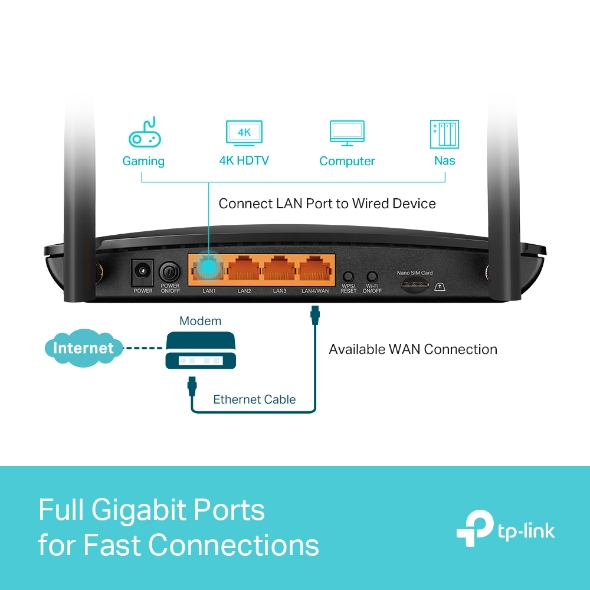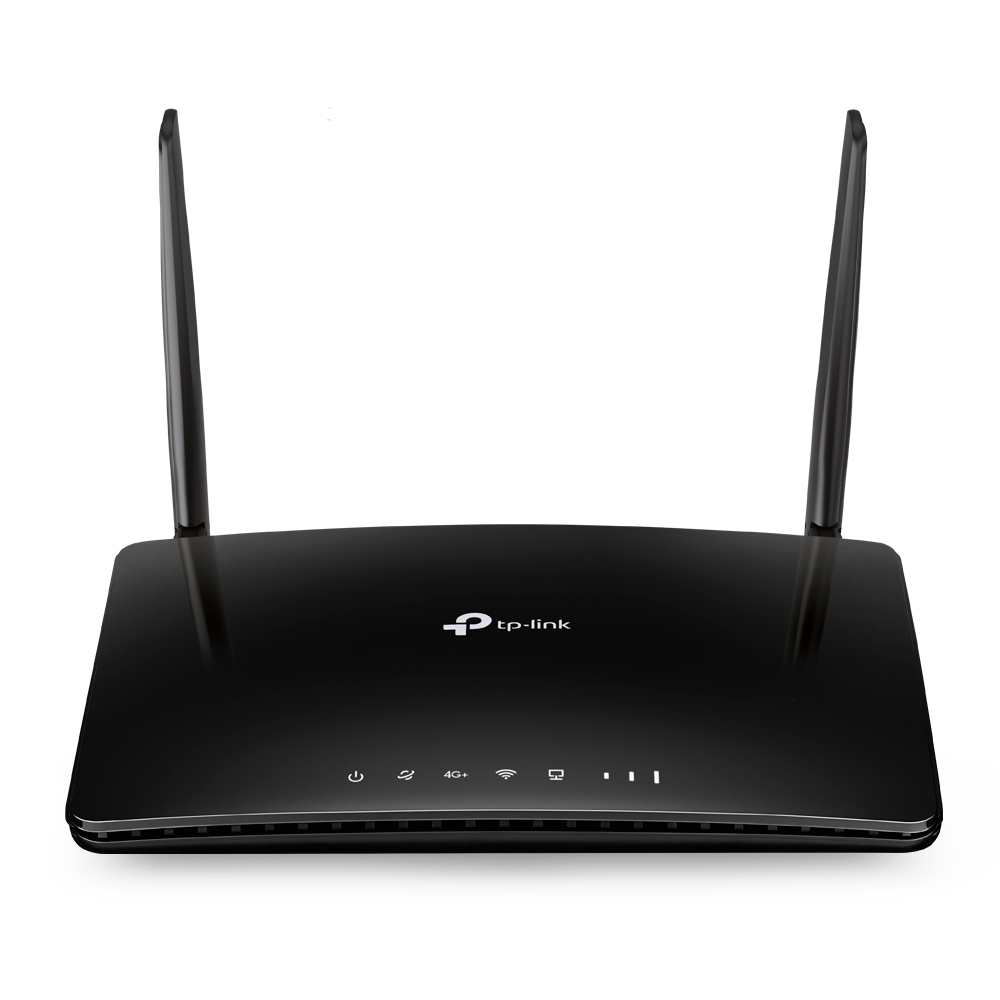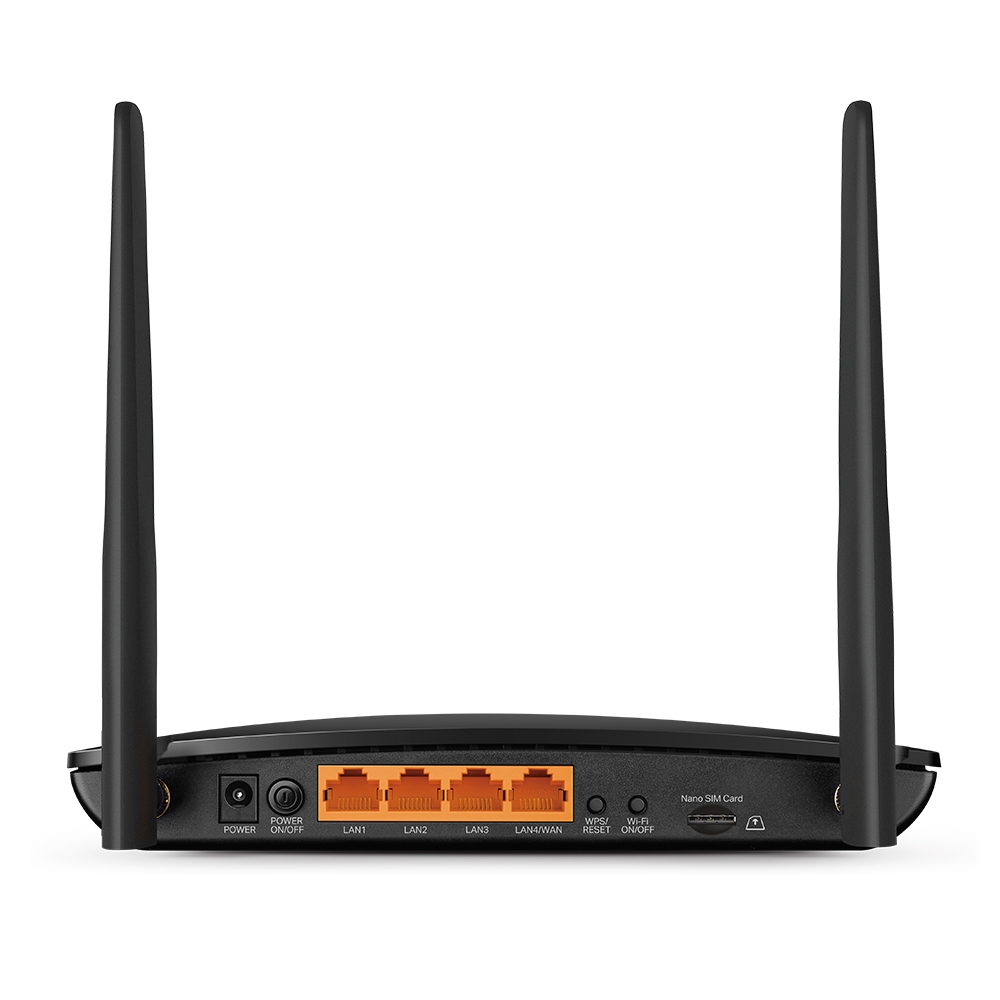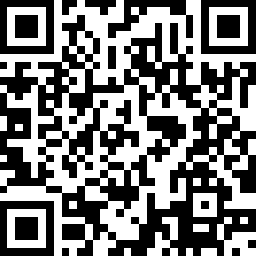4G+ Cat6 AC1200 Wireless Dual Band Gigabit Router
- TP-Link's First 4G+ Router – supports 4G+ Cat6 to boost the data speeds of up to 300 Mbps*
- Plug a SIM card and play – no configurations needed, compatibility of SIM cards in 100+ countries are assured by years of field tests
- MU-MIMO supported – simultaneous data streams increase WiFi throughput and network efficiency.
- Supports TP-Link OneMeshTM – co-works with TP-Link OneMesh products to create a flexible and cost-efficient Mesh network
- Better Signal for Connections Everywhere – enjoy stable and efficient connections to every device thanks to the two external LTE antennas
- Full Gigabit Ports – provides reliable wired connections for bandwidth-intensive devices such as game consoles and STB
- Wi-Fi router mode – plug an Ethernet cable into the LAN/WAN port for flexible access if you can't get a 4G connection
- Easy setup and management all by Tether app
Enjoy 4G+ Speed Sharing Everywhere
4G+ Cat6 AC1200 Wireless
Dual Band Gigabit Router
Archer MR600
Fast Wi-Fi Where You Need It
Searching for a stable and flexible network connection? Archer MR600 provides both as a 4G+ LTE WiFi router. Compared with traditional WiFi routers, it integrates 4G+ and WiFi technology, meaning MR600 acts like a phone and needs only a Nano SIM card to get internet access. Experience stable WiFi and share it with your family and friends wherever you are.
-
Lodging Home
-
Remote Area
-
Temporary Store
-
Holiday Home
Boost Your Broadband Speeds with Stable 4G+ Internet
Whether you’re bingeing HD movies, downloading entire libraries of data, or gaming online, MR600’s boosted 300 Mbps download speeds fulfills your devices’ needs. Such fast broadband and reliable internet access is thanks to its 4G+ Carrier Aggregation technology which combines different carrier signals for even faster bandwidth.
4G LTE Router
4G+ Cat6 Router
300 Mbps
LTE Speed
Share Powerful Dual Band WiFi with Everyone
MR600 creates a reliable and blazing-fast network powered by 802.11ac Wi-Fi technology. The 2.4 GHz band delivers speeds up to 300 Mbps for everyday tasks like emailing and web browsing, while the 5 GHz band delivers speeds up to 867 Mbps—ideal for HD video streaming and lag-free online gaming.
867 Mbps
5 GHz Band
300 Mbps
2.4 GHz Band
Connect up to
64
WiFi Devices
Vast WiFi Coverage Throughout Your Home
Connect to the internet in every room with an expansive and strong AC1200 dual band WiFi. MR600’s Beamforming concentrates signals towards your connected devices. Its Power Amplifier and Low Noise Amplifier also amplify sending and receiving capabilities, both of which boost your signal coverage.
-
 2.4GHz
2.4GHz
-
 5GHz
5GHz
More Data Streams with MU-MIMO Technology
MU-MIMO technology enables multiple devices to connect to the internet at the same time, reducing wait time, increasing WiFi throughput for every device, and boosting the efficiency of each data stream. With MU-MIMO supported, Archer MR600 provides users a faster network, less interference, and lower latency.
Traditional 4G Router
Archer MR600 with MU-MIMO Technology
Seamless Roaming with TP-Link OneMesh™
Enjoy a stable, whole-home WiFi connection even while you’re moving around your home. MR600 works with TP-Link OneMesh products to create a seamless network under a single Wi-Fi name.
Range Extender
Archer MR600
Whole-Home Mesh Wi-Fi
Full Gigabit Ports for Fast Connections
Full Gigabit Ethernet ports provide reliable, warp-speed connections for high-intensive wired devices such as your smart TV, game console, NAS, and more. MR600 also provides a WAN port compatible with cable, fiber, and DSL modems. When it’s set as a wireless router, its 3G/4G connection works as a backup to provide a solid internet connection for you.
Gaming
4K HDTV
Computer
Nas
Connect LAN Port to Wired Device
Modem
Internet
Ethernet Cable
Available WAN Connection
| HARDWARE FEATURES | |
|---|---|
| Interface | 1 × 10/100/1000 Mbps LAN/WAN Port3 × 10/100/1000 Mbps LAN Ports1 × Nano SIM Card Slot |
| Button | WPS/Reset Button, WiFi On/Off Button, Power On/Off Button |
| External Power Supply | Power Adapter: : Input Power 100-240v~50/60 Hz 0.6AOutput parameter 12VDC 1.5A |
| Dimensions ( W x D x H ) | 202 × 141 × 33.6 mm (7.95 × 5.55 × 1.32 in) |
| Antenna | 2 × Detachable 4G LTE Antennas |
| WIRELESS FEATURES | |
|---|---|
| Wireless Standards | IEEE 802.11a/n/ac 5 GHz, IEEE 802.11b/g/n 2.4 GHz |
| Frequency | 2.4 GHz and 5 GHz |
| Signal Rate | 300 Mbps at 2.4 GHz, 867 Mbps at 5 GHz |
| Reception Sensitivity | 5 GHz: 11a 54M: -77 dBm11ac HT20: -73 dBm11ac HT40: -68 dBm11ac HT80 : -64 dBm11n HT20: -77 dBm11n HT40: -73 dBm2.4 GHz: 11g 54M: -74 dBm11n HT20: -72 dBm11n HT40: -69 dBm |
| Wireless Functions | Enable/Disable Wireless Radio, Wireless Schedule, WMM, Wireless Statistics |
| WAN Failover | Yes |
| Wireless Security | 64/128-bit WEP, WPA/WPA2, WPA-PSK/WPA2-PSK encryptions |
| Transmission Power | < 20 dBm (2.4 GHz), < 23 dBm (5 GHz) |
| Network Type | 4G: FDD-LTE: B1/B3/B5/B7/B8/B20/B28 (2100/1800/850/2600/900/800/700 MHz) TDD-LTE: B38/B40/B41 (2600/2300/2500 MHz)3G: DC-HSPA+/HSPA/UMTS: B1/B5/B8 (2100/850/900 MHz)Carrier Aggregation:B1+B3/B5/B7/B8/B20B3+B1/B3/B5/B7/B8/B20/B28/B38/B40B5+B1/B3/B5/B7/B40B7+B1/B3/B5/B7/B8/B20/B28B8+B1/B3/B7B20+B1/B3/B7B28+B3/B7/B40B38+B38B40+B40B41+B41 |
| SOFTWARE FEATURES | |
|---|---|
| Quality of Service | Bandwidth Control |
| Security | DoS, IPv4 SPI Firewall, IPv6 Firewal, IP and MAC Address Binding, Access Control |
| WAN Type | Dynamic IP/Static IP/PPPoE/PPTP(Dual Access)/L2TP(Dual Access) |
| Management Features | TP-Link Cloud, Local Management, Remote Management |
| DHCP | Server, DHCP Client List, Address Reservation |
| Port Forwarding | ALG, Virtual Server, Port Triggering, UPnP, DMZ |
| Dynamic DNS | TP-Link, DynDns, NO-IP |
| VPN | PPTP VPN, OpenVPN |
| Access Control | Parental Control, Local Management Control |
| Protocols | IPv4, IPv6 |
| Guest Network | 2.4 GHz Guest Network x 1, 5 GHz Guest Network x 1 |
| OTHERS | |
|---|---|
| Certification | CE, RoHS |
| Package Content | 4G+ Cat6 AC1200 Wireless Dual Band Gigabit Router Archer MR600Power AdapterRJ45 Ethernet CableQuick Installation Guide |
| Environment | Operating Temperature: 0℃~40℃ (32℉ ~104℉)Operating Humidity: 10%~90% non-condensingStorage Humidity: 5%~90% non-condensing |
*Maximum wireless signal rates are the physical rates derived from IEEE Standard 802.11 specifications. Actual wireless data throughput and wireless coverage, and quantity of connected devices are not guaranteed and will vary as a result of network conditions, client limitations, and environmental factors, including building materials, obstacles, volume and density of traffic, and client location.
